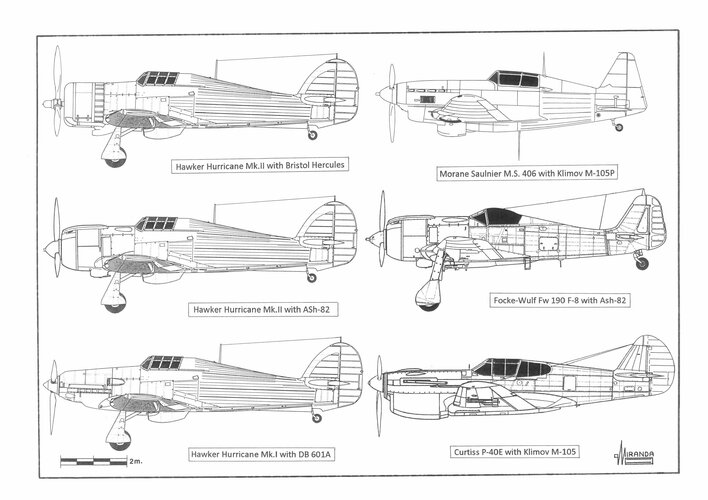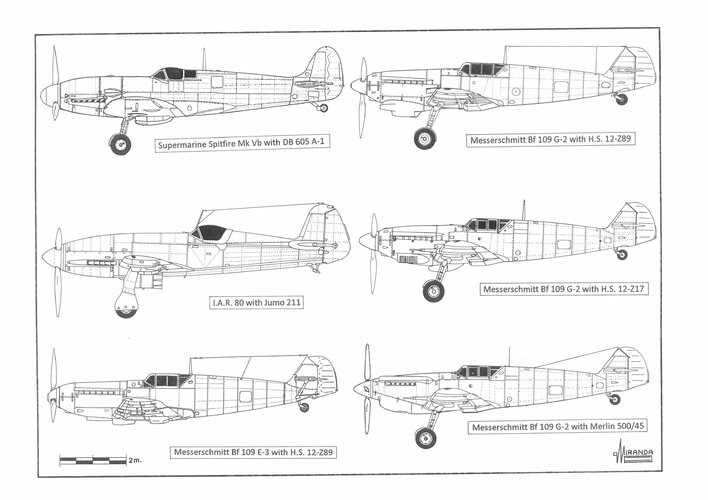With Enemy Core
The lack of the right engines in the international market during the World War Two, caused the appearance of many different prototypes of hybrid fighters. Engines and airplanes of both bands were exchanged with experimental purposes.
In 1938 the Yugoslavian Government acquired 24 Hawker Hurricane fighters, together with the manufacturing licence to allow production of another 100 units in the factories of Zmaj and Rogozarski. However, by the time of German onslaught on April 1941, only 20 Hurricanes had been delivered to the Royal Yugoslav Air Force. When entering the war, the British Government suspended the exports of
Merlin engines, required for their own defence.
As an alternative, the engineers Ilic and Sivcev of the Ikarus-Zemun factory, experimentally installed the German Daimler Benz DB 601A engine in one of the Hurricane IK-Z of local manufacturing. New engine bearers had to be built for the transformation, as well as a redesign of the electrical and cooling systems.
The new machine was named LVT-1 (Lovac Vazduhoplovno Tehnichi-1) and flight tested by the captain pilot Milos Bajagic in the Summer of 1940, proving better take-off performance and climb rate that either the Hurricane Mk.I of the Bf 109 E.3
The Ikarus LVT-1 "Hurrischmitt" was a bit faster than the Hurricane IK-Z although not as much as the Bf 109 E.3.
By early 1941, several proposals were made for the installation of alternative power plants in the Hawker Hurricane Mk.II, to alleviate possible shortages of Merlin Engines. The Rolls-Royce
Griffon IIA, Napier
Dagger and Bristol
Hercules engines were considered.
Britain had provided the Soviet Union a total of 2,952 Hurricanes and there were strong rumours that at least one of them was powered by one 1,250 hp Shvetsov ASh-82 radial engine and armed with two 20 mm ShVAK cannons and four 0.5 in UBT machine guns.
By early 1942 a 1,200 hp Jumo 211 in-line engine from a Savoia Marchetti S.M. 79B bomber was mounted into the I.A.R. 80 c/n 111 Romanian fighter, but during flight tests the aircraft experimented destructive vibration problems and the experiments were discontinued.
At the end of 1943 a DB 601 Aa from Bf 109 E-3 was installed in the I.A.R. 80 c/n 13, performing some test flights.
On 29 June 1943, the I.A.R. 81C c/n 326 was fitted with a 1,475 hp DB 605A engine on an experimental basis.
By mid-1942 a number of Curtiss P-40E that had been provided to the Soviets, under the Lend-Lease arrangements, were re-engined with one 1,100 hp Klimov M-105 engine and pressed into service with several Aviation Regiments.
On April 1942, one Rogozarsky IK-3 prototype was converted from H.S.12Y-29 to a Daimler Benz DB 601 engine.
On 18 November 1942, the Spitfire Mk Vb (EN 830) of the 131st Sqn of the RAF was captured virtually intact by the Germans, after a forced landing in France. It was sent for experimentation purposes to the Daimler Benz test centre of Echterdingen, south of Stuggart, in 1943. One DB 605 A-1, with new engine support, was installed. To that purpose, fuel and oil tanks and new refrigeration system had to be redesigned the electrical system and starter were also changed into a 24 V.
The propeller was a standard VDM with a diameter of 3 meters. The conversion was completed at the Sindelfingen factory with the installation of one Bf 110G engine cowling with the carburettor scoop from a Bf 109 G. The "Spitschmitt" received the radio code letters CJ+ZY performing its comparative
flight tests against a Bf 109 G in the Rechlin test center. It proved its superiority on both visibility and handling on the ground as well as in the climb rate, compared to the standard Bf 109 G. The maximum speed was also estimated above 11,000 feet, but the maximum power of the engine could not be tested, due to deficiencies in the air coolant system.
The Spanish Government ordered the modification of the Bf 109 E-3 (6-119) in 1942 replacing the engine by one 1,300 hp Hispano Suiza H.S.12-Z89. The prototype, named H.A.1109 J1, was flight tested in Muntadas-Barcelona by Lt. Lacour in October 1942, revealing problems of overheating. By the beginning of 1945, one H.S.12-Z89 was installed in the Bf 109 G-2 airframe imported from Germany. The new model was named H.A.1109 J1L, flying for the first time with a three-bladed Hamilton Standard propeller on 2 March 1945, without solving the engine overheating problem.
In 1951, it was decided to replace the engine by the H.S.12-Z17 variant, considered more secure. The new H.A.1109 K version was equipped with a three-bladed de Havilland PD-63 propeller and went into service for the
Ejercito del Aire in a number of 30 units. Other Bf 109 G-2 were converted into the H.A.1112 M by installing the British R.R.
Merlin 500/45 engines with four-bladed Rotol R-116 propellers from the summer of 1953.
None of these transformations (profoundly disgusting for Willy Messerschmitt) produced any satisfactory result.
In Finland, forty-one ex-French fighters Morane-Saulnier M.S.406 were re-engined, in June 1944, as
Mörkö Moraani (525 kph) with one 1,100 hp Klimov (Hispano-Suiza) M-105 P driving one VISh-61 constant-speed airscrew and armed with one engine-mounted 20 mm MG 151 cannon and two wing-mounted 7.7 mm (belt feed) Browning machine guns.
In 1946, one Focke-Wulf Fw 190 F-8 was re-engined with one 1,250 hp Shvetsov ASh-82 radial engine in the LII VVS (Soviet Air Force Test Flying Institute) and kept in flight condition until 1951.


